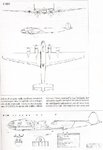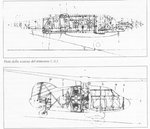red admiral
Senior Airman
- 479
- Mar 24, 2005
Campini CS3. 3 Isotta Fraschini L121 inline engines driving propellors. Outer engines drive burners like CC2. Central engine provides supercharging for others above 5000m.
Piaggio 112. Refined P108 with different nose and tail.
Piaggio 114. P112 with floats.
Piaggio P.133 was a new strategic bomber and the construction of the 1st prototype was 90% finished on 8 Sept. 1943 (the armistice).
engines: 4 x 1,700 hp
max speed: 490 km/h
authonomy: 5,100 km
bombload: 4,800 kg
armament: 4 x 12,7 and 6 x 20 mm (2 dorsal turrets, 2 lateral, 1 tail, 1 ventral and 4 anterior)
Aero P.123 long range bomber
Cant Z.1014 long range bomber. Competitor to P108 and definitely superior. 500kph+ projected speed. 6x20mm cannon. P108 later "won" due to Piaggio halving the price.
Source is mostly Aerofan.


